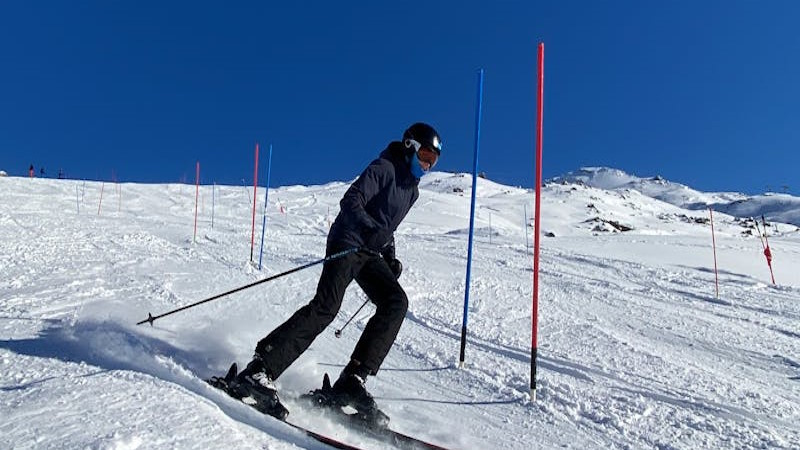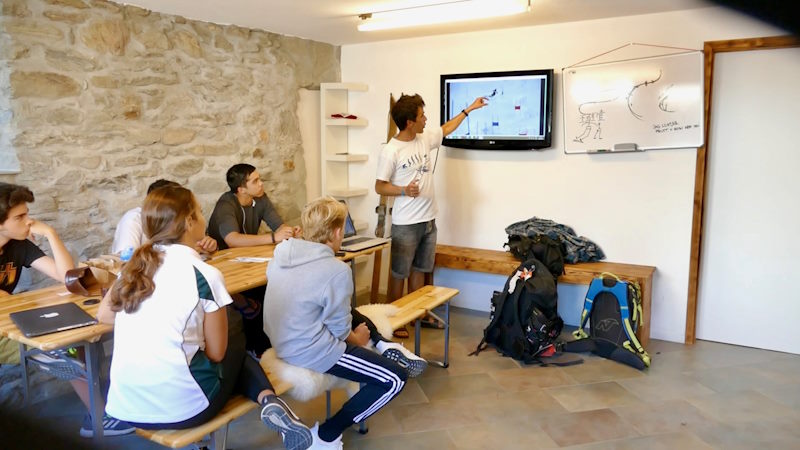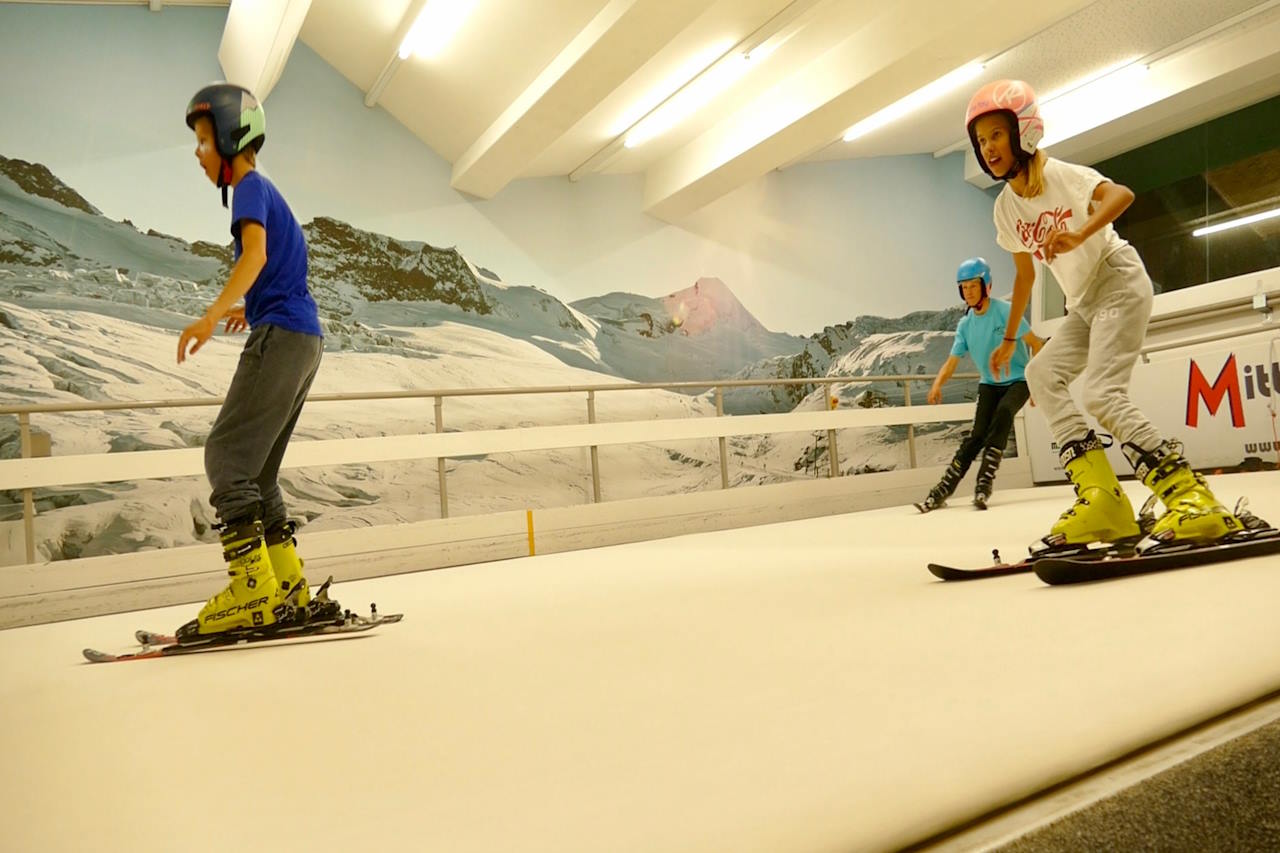If you are a ski enthusiast and are just beginning to immerse yourself in this world, it is very likely that you have asked yourself the question: How long does it take to learn skiing?
Well, the first thing you should know is that skiing is an exciting sport that requires a combination of physical fitness, determination, and the right environment. It is essential to understand the factors that influence the process of learning to ski, from physical preparation to accessibility.
In general, beginners perform basic maneuvers before advancing to intermediate and advanced levels. Quality instruction can accelerate this process, preventing bad habits and ensuring safe and controlled learning.
By skiing with more experienced people and investing in quality equipment, enthusiasts can overcome challenges such as fear and physical demands, making the learning experience more efficient and enjoyable.
So stay with us and keep reading to better understand the process of becoming a professional skier and get a clearer picture of how long it might take you to develop this skill.
Content
Factors influencing the time to learn skiing
Physical fitness and skiing
To begin with, it’s important to understand that aspiring skiers need to recognize that physical fitness plays a crucial role in the time it takes to learn to ski.
As with any sport, a higher level of fitness can significantly accelerate the learning process. Why? Because skiing demands strength, flexibility, and endurance.
Think for a moment about the scenario where you’re trying to navigate a steep slope. Without the necessary strength, each turn becomes a struggle and fatigue sets in quickly. Improving cardiovascular endurance allows skiers to make the most of their time on the slopes without tiring rapidly.
However, fitness levels vary from person to person. Someone who exercises regularly and has a solid physical foundation will likely progress faster than someone who leads a sedentary lifestyle.
Therefore, incorporating an exercise routine focused on leg strength, core stability, and cardiovascular health can make a big difference in mastering skiing. To achieve excellent physical condition, you can try activities such as running, cycling, and practicing yoga.
Importance of environment and accessibility
Another important aspect to consider when learning to ski is the environment, as it significantly influences the learning time. Access to quality ski facilities and constant exposure to suitable terrains are fundamental.
Have you ever considered how easy it is to improve when you have the right resources at your disposal? Ski resorts with various slope difficulties allow learners to progressively challenge themselves.
Starting on gentle slopes, new skiers can gradually advance to more challenging terrains. Reliable snow conditions also play a role, as inconsistent snow quality can hinder practice. Additionally, geographical proximity to ski areas can either facilitate frequent practice or become an obstacle.
Skiers living near mountainous regions have the advantage of practicing more regularly, which accelerates the learning curve. Consider the skier who has to travel long distances to reach ski areas. Undoubtedly, it will be more difficult for them to practice regularly compared to someone who lives nearby.
The frequency and quality of practice are key factors in mastering skiing skills. Therefore, choosing the right environment and ensuring accessibility are essential to minimizing the time required to master skiing.
Role of determination and commitment
Finally, the determination and commitment of the skier are pivotal. Why do some people progress faster than others? Often, it’s due to their dedication and willingness to push through challenges.
Learning to ski is not without its difficulties. Falls and failures are part of the process. However, a skier’s mental attitude—one characterized by perseverance, resilience, and a willingness to step out of their comfort zone—greatly influences their learning speed. Are you willing to fall and get back up repeatedly?
Ultimately, those who approach skiing with enthusiasm and persistence find themselves improving at a quicker pace. The journey from novice to expert is as much a mental endeavor as it is physical.

Typical learning timeline for skiing
Initial skills and basic maneuvers
Beginner skiers typically start their journey by mastering initial skills and basic maneuvers. This fundamental phase usually lasts between one and three days, depending on individual aptitude and learning conditions. The essential skills involve maintaining balance, stopping, and performing basic turns.
During this stage, emphasis is placed on the snowplow technique. This technique allows beginners to control their speed and direction. The speed at which each person acquires these skills can vary significantly depending on previous experience with similar sports and physical conditioning.
Many novice skiers also take group lessons, which provide a structured learning environment. The group dynamic can enhance learning as participants often motivate each other. What is the benefit of having a common learning goal?
- Shared experiences: It allows learning from others’ mistakes and successes.
- Social support: Encourages perseverance through shared challenges.
- Structured progression: Ensures that fundamental skills are comprehensively covered.
By the end of the first few days, most beginners can navigate gentle slopes with relative confidence. Their new skills lay the foundation for more complex techniques.
Progressing to intermediate levels
Transitioning from beginner to intermediate skiing typically spans several weeks to months. The timeline varies widely, but within approximately ten to twenty practice days on the slopes, skiers generally start to move beyond the basics and develop more refined techniques.
Intermediate skiers focus on linking turns smoothly and skiing on steeper slopes. Mastery of parallel turns is a significant milestone at this stage. Why is this progression crucial?
- Increased Control: Parallel turns enable better speed and direction management.
- Enhanced Confidence: Skiing on steeper terrain builds mental resilience.
- Preparation for Advanced Skills: Establishes a basis for complex maneuvers.
Lessons during this period often become more personalized. Private instructions are beneficial as they tailor feedback to individual needs, speeding up the learning process. How do personalized lessons make a difference?
“Customized feedback can pinpoint precise areas for improvement, accelerating overall progress.”
Intermediate skiers also start to explore carving techniques, which involve creating clean, sharp turns on the edges of their skis. This technical skill takes time to master, requiring consistent practice and feedback.
Achieving advanced skiing techniques
Reaching advanced skiing techniques marks a significant achievement in a skier’s journey. Typically, this phase can take several seasons of consistent practice. Advanced skiers are proficient in various terrains and conditions, showcasing skills like off-piste skiing, moguls, and advanced carving.
Advanced skills often require overcoming psychological barriers. Skiers must be comfortable with high speeds and more complex maneuvers. What mental attributes are essential at this level?
- Determination: Persistent effort is crucial for mastering advanced techniques.
- Confidence: Belief in one’s abilities to tackle challenging runs.
- Adaptability: Ability to adjust techniques in varying conditions.
Training at this level often involves specialized coaching, where skiers receive guidance on minute details that refine their technique. Participation in advanced camps can also be beneficial. Do such intensive training sessions make a noticeable impact?
In essence, advancing to an expert level is an ongoing process, characterized by continual learning and adaptation. Each skier’s timeline will vary based on dedication, frequency of practice, and quality of instruction.
The benefits of quality ski instruction
Preventing bad habits early
Like any skill we develop in life, learning to ski is no different. Establishing good habits from the start is crucial for your long-term success. Professional instructors are here to help you avoid developing incorrect techniques that could be difficult to correct later on.
Imagine having to unlearn a bad skiing habit you’ve practiced for years. It’s much easier to learn the right way from the beginning, right? Professional instruction ensures that fundamental skills are taught properly.
Moreover, bad habits can be risky for your safety. Skiing with incorrect posture or technique can lead to injuries. By learning from a professional, you can significantly reduce these risks.
So, why struggle to correct mistakes later when you can avoid them with good instruction from the start?
Tailored lessons for skill levels
Professional ski instructors assess each skier’s skill level and tailor the lessons accordingly. This personalized approach ensures that your learning is efficient and effective.
Consider the difference between a beginner learning basic snowplow techniques and an advanced skier perfecting their carving skills. A one-size-fits-all instruction method could not meet these diverse needs.
By identifying your strengths and weaknesses, instructors can focus on the areas you need to improve, making the learning process faster and more enjoyable.
- Beginner lessons: Focus on fundamental skills such as balance and basic turns.
- Intermediate lessons: Introduce more complex techniques such as parallel turns and edge control.
- Advanced lessons: Refine your techniques and prepare you for more challenging terrain.
Wouldn’t you prefer lessons specifically designed for your skill level, making each session productive and rewarding?

Tips and tricks to expedite skiing skills
Invest in quality equipment
A high-quality ski set can make a significant difference in your learning curve. Reliable equipment not only guarantees safety but also enhances your performance. For example, well-fitted boots provide better control and reduce the risk of injury, allowing you to focus on improving your technique.
When purchasing equipment, consult with professionals who can guide you on the best products suited to your skill level and goals. Here are some tips that can help you:
- Research and consult experts: before investing, seek advice from experienced skiers or professionals.
- Consider renting before buying: this allows you to try various brands and models to find the one that fits best.
- Look for deals and discounts: many ski resorts and stores offer discounts on high-quality equipment, especially during the off-season.
Ultimately, the right equipment can accelerate your learning process by providing comfort and improving performance, allowing you to concentrate on mastering your skills.
Overcoming common challenges in learning to Ski
Dealing with fear and anxiety
Starting a new activity like skiing can be daunting, especially when it involves navigating snowy slopes. Fear and anxiety are natural responses, but they can be effectively managed.
First, it’s important to acknowledge your feelings. Are you anxious about falling? Nervous about going too fast? Once you identify the source of your fear, you can take steps to address it. A useful strategy is to focus on breathing techniques. Deep, controlled breathing can keep anxiety at bay and help you stay calm.
Additionally, taking a gradual approach to skiing can ease your fears. Begin with gentle slopes and progressively move on to more challenging ones. This way, your confidence will steadily increase.
Consider taking lessons from a professional instructor. They can provide personalized guidance and support, which can greatly reduce your fear. Visualization techniques are also beneficial. Picture yourself skiing confidently down a slope. This mental practice can prepare you for the real experience.
Finally, remember that falling is part of the learning process. Each fall brings you closer to mastering the skill. How do you view falls: as failures or learning opportunities?
Managing physical demands
As we mentioned earlier, skiing requires a certain level of physical fitness, but you don’t need to be an athlete to start. Understanding the physical demands can help you prepare better. Before hitting the slopes, it’s essential to warm up your body. Simple exercises like stretching and light cardiovascular exercises can prevent injuries.
Building strength, especially in the legs and core, is very beneficial. Exercises like squats, lunges, and planks can make a significant difference. Endurance is equally important. Aerobic activities such as running, ice skating, cycling, or swimming can increase your stamina.
- Warm-up exercises: prepare your muscles for the physical activity ahead.
- Strength training: focuses on building muscle strength, particularly in key areas.
- Cardiovascular workouts: improve cardiovascular health and endurance.
Hydration plays a vital role in managing physical demands. Skiing at high altitudes can dehydrate you quickly, so drinking plenty of water is essential. Additionally, regular breaks are important. Overexerting yourself can lead to fatigue and increase the risk of injury. Listen to your body’s signals.
Maintaining a balanced, nutrient-rich diet will fuel your body for skiing. Foods high in carbohydrates, proteins, and healthy fats provide sustained energy. Finally, as we also mentioned earlier, proper equipment is crucial. Ensure your ski boots fit well and your skis are appropriate for your skill level. Can poorly fitting equipment affect your performance? Definitely!
Staying motivated and consistent
Maintaining motivation is key to progressing in skiing. Set realistic goals to keep yourself committed and focused. Documenting your progress can be very motivating. Consider keeping a journal or recording videos of your practice sessions.
Finding a ski partner can make the experience more enjoyable. An encouraging partner can provide support and make the learning process less intimidating. It is also beneficial to create a structured practice schedule.
Regular practice improves consistency and skill retention. Scheduling specific times to ski each week can help incorporate it into your routine. How can a consistent schedule aid in skill development?
Participating in local ski clubs or online communities can offer additional support. Engaging with others who share similar goals can inspire and motivate.
It is essential to celebrate your achievements, no matter how small. Recognizing your progress can maintain your enthusiasm and drive. Lastly, remember that setbacks are part of the journey. Embrace challenges and view them as opportunities for growth.
Conclusion
We have reached the end of this article, and we are glad that you have accompanied us this far. As you observed, the journey towards mastering skiing depends on a combination of physical aptitude, commitment, and access to quality instruction.
Factors such as the environment and the skier’s determination play fundamental roles and determine the pace and success of learning. As we mentioned, starting with basic maneuvers and progressing to intermediate and advanced techniques can be significantly accelerated with proper guidance and personalized lessons.
Additionally, investing in quality equipment and leveraging technology and workshops can transform initial struggles into milestones of achievement. Engaging with experienced skiers and facing common challenges such as fear and physical demands ensures a consistent and motivated learning approach.
So, determining an exact time to learn to ski depends on each enthusiast’s physical capability and skills. However, the more you immerse yourself in practice, the greater your chances of learning in a short period. Embrace the adventure, focus on consistent practice, and take advantage of professional instruction to master the exciting world of skiing.
If you wish to learn with professional instructors, we invite you to contact us. Our team is made up of experienced ski professionals dedicated to helping you achieve your skiing goals. We offer group sessions that provide a fun and social learning environment, as well as private lessons tailored to your individual needs and pace.
Whether you are a beginner looking to master the basics or an advanced skier aiming to perfect your technique, we have the perfect program for you. Join us on the slopes and learn to ski like an expert with guidance from our expert instructors. Contact us today to start your skiing adventure.
